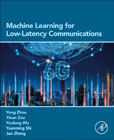
Machine Learning for Low-Latency Communications
Zhou, Yong
Zou, Yinan
Wu, Youlong
Shi, Yuanming
Zhang, Guangjun
Machine Learning for Low-Latency Communications presents the principles and practice of various deep learning methodologies for mitigating three critical latency components: access latency, transmission latency, and processing latency. In particular, the book develops learning to estimate methods via algorithm unrolling and multiarmed bandit for reducing access latency by enlarging the number of concurrent transmissions with the same pilot length. Task-oriented learning to compress methods based on information bottleneck are given to reduce the transmission latency via avoiding unnecessary data transmission. Lastly, three learning to optimize methods for processing latency reduction are given which leverage graph neural networks, multi-agent reinforcement learning, and domain knowledge. Low-latency communications attracts considerable attention from both academia and industry, given its potential to support various emerging applications such as industry automation, autonomous vehicles, augmented reality and telesurgery. Despite the great promise, achieving low-latency communications is critically challenging. Supporting massive connectivity incurs long access latency, while transmitting high-volume data leads to substantial transmission latency. Presents the challenges and opportunities of leveraging data and model-driven machine learning methodologies for achieving low-latency communicationsExplains the principles and practices of modern machine learning algorithms (e.g., algorithm unrolling, multiarmed bandit, graph neural network, and multi-agent reinforcement learning) for achieving low-latency communicationsGives design, modeling, and optimization methods for low-latency communications that apply appropriate learning methods to solve longstanding problemsProvides full details of the simulation setup and benchmarking algorithms, with downloadable codeOutlines future research challenges and directions INDICE: Part 1: Introduction and Overview1. Introduction and overviewPart 2: Learning to Estimate for Access Latency Reduction2. Learning to estimate via group-sparse based algorithm unrolling3. Learning to estimate via proximal gradient-based algorithm unrolling4. Learning to detect via multiarmed bandit (MAB)Part 3: Learning to Compress for Transmission Latency Reduction 5. Learning to compress via information bottleneck6. Learning to compress via robust information bottleneck with digital modulation7. Learning to compress for multi-device cooperative edge inferencePart 4: Learning to Optimize for Processing Latency Reduction 8. Learning to optimize via graph neural networks9. Learning to optimize via knowledge guidance10. Learning to optimize via decentralized multi-agent reinforcement learningPart 5: Conclusions 11. Conclusions and Future Research Directions
- ISBN: 978-0-443-22073-9
- Editorial: Academic Press
- Encuadernacion: Rústica
- Páginas: 366
- Fecha Publicación: 01/11/2024
- Nº Volúmenes: 1
- Idioma: Inglés
